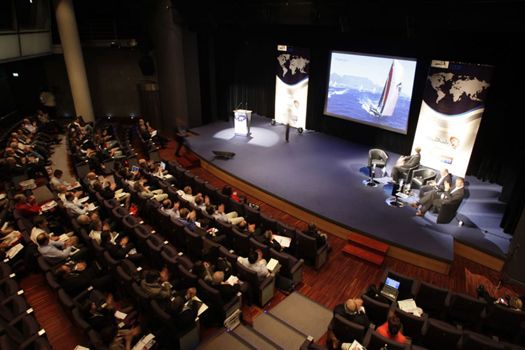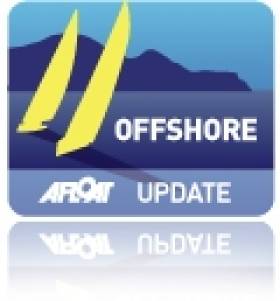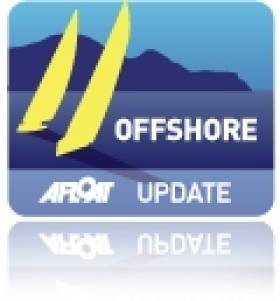Displaying items by tag: Loick Peyron
Banque Populaire V Takes Jules Verne Trophy, Smashing World Record
#WORLD RECORD - France's Banque Populaire V has smashed the record for the fastest yacht sailing around the world, shaving nearly three days off the previous best.
BBC News reports that the yacht's 14-man crew crossed the line at 45 days, 13 hours, 42 minutes and 53 seconds to claim the Jules Verne Trophy - knocking 2 days, 18 hours, 1 minute and 59 seconds off the standing world record set by Groupama 3 nearly two years ago.
The 40-metre trimaran, which last year also set a record time in the gruelling Fastnet Race, raced around the globe with an average speed of 26.5 knots.
And the Loïck Peyron-skippered yacht would have beaten the challenge even sooner had it not been delayed for almost two days due to bad weather.
"It was an amazing feeling crossing the line," said crew member Brian Thompson in an audio interview with sailor Hannah White.
Franck Cammas, skipper of Groupama 3 and currently competing in the Volvo Ocean Race, also offered his congratulations to the Banque Populaire team.
"Obviously it's a superb performance as it's always complicated to sail around the world," he told Sail World. "Aboard boats which go so fast, you have to know how to keep pace and drive them at the right speed so as not to break them.
"The crew of Banque Populaire knew how to do it and they did a fine job."
Champion Jean Pierre Compares Foxall and Peyron
Jean Pierre Dick has been talking about preparations for the defence of his title later this month in an interview on the Barcelona race website. He won the global double-handed race in 2008 with Kerry's Damian Foxall. In the latest interview Dick gives a few interesting insights on Ireland's top offshore sailor and how sailing with him compares with Dick's current partner, the famous French offshore sailor Loick Peyron.
Excerpts below and full article HERE
What are the main differences between Damian and Loïck as sailors and who will how you work together compare with last time?
" Last time Damian was more looking after the boat, if there were things to repair he was the man and maybe more at the front of the boat, I was more into picking the weather. Now with Loïck it will be more equivalent, I will be more equal on the repairs this time which is good for my training for the Vendée Globe. And for sure Loïck is very knowledgeable on his weather analysis, so we will work together. If there is a security decision I am the skipper and the owner of the boat, and the project, and they are my sponsors, so that becomes my task, but I want Loïck to be involved in the strategy and the thinking in this race. In this race what makes you successful is the interaction between the two skippers. It is important that we know work well together, we have done some training together and we have done some weather analysis together, so there will be the same level of information."
What are the main differences between the two?
" Loïck has such huge experience, Damian also has huge experience but it is coming more from the Volvo also, Loïck's (experience) is more....well, everything sailing! So I would say the main difference is Damian is a very physical guy, very strong. Loïck is more using his brain to sail smart, to make less effort. So that is how I see things, but there is a change for sure but I will learn more about both experiences as we go. Loïck has more experience with single and double handed races, maybe I would say more experience over his while life. Damian has been more on more physical races like the Volvo. Both are very able to repair the boat, to sail the boat on their own, they would have been able single handed even though Damian did not do more, he would be very talented to do so."
World Yachting Forum Calls For Change
Delegates attending the World Yacht Racing heard calls for change, modernity and new ways of thinking. These were the main themes at the heart of the conference, which concluded yesterday in Estoril, Portugal.

The forum also discussed topics on new media, host cities, sustainable development, the America's Cup and the Olympic Games. The overall consensus arising from the forum concluded that this was a time of transition and there was a need to adapt.
"Sailing is like the Himalayas, there are many 8000 summits: the Cup, the Vendée Globe, the Olympic Games... all of them are difficult to achieve and very different from each other", said Loïck Peyron, the veteran global ocean racer and multi-hull skipper.
"The America's Cup is the perfect illustration following last springs' schism: we all share the same God but not the same religion." he added during his keynote speech.
In order for yacht racing to grow the sport requires ways to find cost effective strategies to grow new audiences via TV and new media. For information about the principle speakers including Maria Ferreras, Head of Partnerships for YouTube, click here . For further details from the conference logon to www.worldyachtracingforum.com/index.html
Channel 4 to Broadcast Documentary on Britain's Round the Island Race'
'Spectacular', 'awe-inspiring' and 'exhilarating' are all words attributed to the J.P. Morgan Asset Management Round the Island Race and if you were one of the 16,000 sailors who took part this year, you will have the chance to re-live your race through a two-part Channel 4 documentary airing this month. A must-watch for all sports and sailing fans, Part 1 will air Saturday 13th November 2010, at 7.30am on Channel 4 and Part 2 goes out on Saturday 20th November 2010, at 7.30am on Channel 4.
The Race
Every year in June over 16,000 sailors, from Olympic gold medallists and world champions to family crews and those trying their hand at racing for the first time, compete in this unique yacht race around the Isle of Wight that is organised by the Island Sailing Club in Cowes. In most racing events the top prize usually goes to the first entry across the finish line; this is where the Round the Island Race differs. The coveted prize is the Gold Roman Bowl that is won by the crew with the best corrected time, worked out through a handicap system. This means big or small, all boats have the opportunity to win the grand prize.
Highs and lows
The two-part programme, produced by Sunset+Vine|APP in association with Channel 4, tells the story of four very different personalities, each with special reasons to compete in the 2010 race. The first part of the documentary takes the viewer into the day-to-day world of each of the four sailors, as they prepare for the fourth largest participation sporting event in the UK. The second part is filmed during the race itself with onboard cameras showing the highs and the lows as they compete against a fleet of some 1,700 boats.
The Cast
The first to feature is a professional multihull sailor, Loick Peyron. He is skippering the boat that crossed the finish line first in 2009. The team from OMAN SAIL are back to try and make it two in a row, racing one of the world's fastest sailboats. Can Loick repeat the team's success? The pressure is on!
The next character is Welsh surgeon Paul Rhys-Davies. Experience-wise he is a polar opposite to Loick. Paul is a newcomer to the world of sailing and hasn't even entered a race before! He is determined to finish his 50-nautical mile lap of the Isle of Wight with his rookie crew but their pre-race training doesn't go to plan and Paul is so nervous that he is unable to sleep the night before the race.
Having competed in the race numerous times, a man who understands the handicap system well is Cowes-based designer Jo Richards. For the 2010 edition he decided to design and build a small boat to race. He knew it would take much longer than most boats to finish the race, yet owing to its handicap rating, his boat named Moonshadow could still win the coveted Gold Roman Bowl. The story of Jo Richards begins with a race against time to complete the build of his boat, obtain a rating and make it to the start line.
The final competitor is competing not to win but to celebrate beating cancer. Dennise Shepherd is in recovery from breast cancer and has set herself the goal to complete the J.P Morgan Asset Management Round the Island Race to raise funds for Breast Cancer Care, the charity that supported her through her treatment. Dennise, from Chester, is used to sailing her tiny Mirror dinghy on a small lake, so competing in a fleet of over 1,700 yachts on open sea will be a massive and emotional learning curve.
Then tune in on the 13th and 20th November to see how they get on and enjoy this 'spectacular', 'awe-inspiring' and 'exhilarating' race from the comfort of your armchair.
Save the dates
Channel 4
Saturday, 13th November 2010 at 7.30am
&
Saturday, 20th November 2010 at 7.30am.



























































